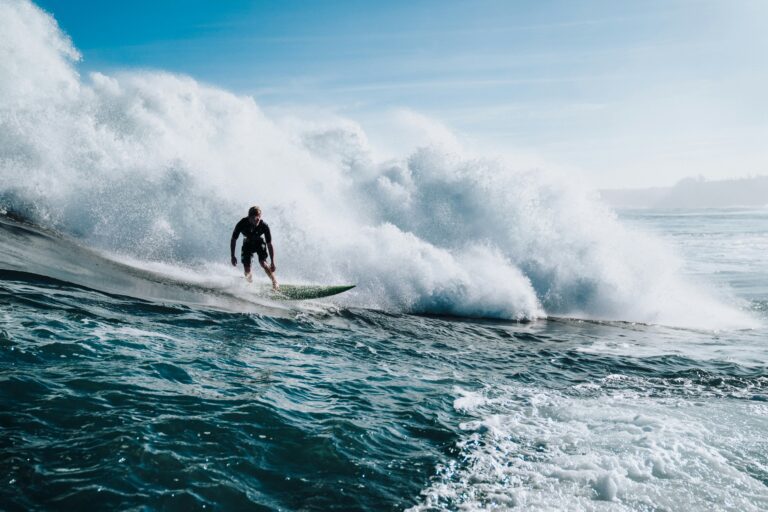Surfing and meditation might seem like activities from opposite ends of the spectrum – one involving adrenaline-fueled excitement, and the other, quiet contemplation. However, as we delve deeper into both practices, we discover a profound connection that transcends their apparent differences. In this article, we explore how the art of riding waves and the practice of inner stillness intersect, offering a unique pathway to finding inner peace amidst the chaos of modern life.
The Serenity of Surfing
Exploring the therapeutic effects of being in the ocean
Surfing isn’t just a sport; it’s a therapeutic experience that connects individuals with the vastness of the ocean. The moment one paddles out into the waves, there’s a profound sense of immersion in nature’s embrace. The therapeutic effects of being in the ocean are manifold, ranging from the calming sound of waves crashing against the shore to the refreshing sensation of saltwater against the skin.
For many, the ocean serves as a sanctuary where they can escape the stresses of daily life. The rhythmic ebb and flow of the tide create a serene environment conducive to relaxation and introspection. Scientific studies have shown that being near the ocean can reduce stress and promote mental well-being. The negative ions present in ocean air contribute to feelings of tranquility and can even alleviate symptoms of anxiety and depression.
The rhythm of the waves and its calming influence
There’s a unique rhythm to the waves that exerts a mesmerizing influence on those who surf. Each wave carries with it a cadence that surfers learn to anticipate and synchronize with. This rhythmic quality of the ocean serves as a natural metronome, guiding surfers into a state of flow where they become attuned to the present moment.
As surfers paddle out beyond the breakers, they immerse themselves in the pulse of the ocean. The rise and fall of each wave create a symphony of motion that is both exhilarating and soothing. Studies have shown that this repetitive motion has a calming effect on the brain, inducing a meditative state similar to that achieved through practices like yoga and mindfulness meditation.
Mindfulness in motion: the focus required while surfing
Surfing demands unwavering focus and attention, requiring surfers to be fully present in the moment. From assessing wave conditions to executing maneuvers on the board, every aspect of surfing necessitates mindfulness in motion. This heightened sense of awareness not only enhances performance but also fosters a deeper connection with the ocean.
As surfers ride the crest of a wave, they enter a state of flow where thoughts dissolve, and only the immediate experience remains. This state of mindfulness allows surfers to let go of distractions and immerse themselves fully in the act of riding waves. The combination of physical exertion and mental concentration results in a profound sense of clarity and fulfillment, making surfing not just a sport but a form of moving meditation.
Meditation: Cultivating Inner Stillness
Definition and benefits of meditation
Meditation is a practice that has been around for centuries, with roots in various spiritual and religious traditions. At its core, meditation involves training the mind to focus and redirect thoughts, ultimately leading to a heightened state of awareness and inner peace. The benefits of meditation extend beyond just mental tranquility; research has shown that regular meditation practice can have a positive impact on both physical and emotional well-being.
One of the primary benefits of meditation is stress reduction. In today’s fast-paced world, stress has become a prevalent issue that can have detrimental effects on health. Meditation offers a natural solution for managing stress by promoting relaxation and inducing a state of deep restfulness. By quieting the mind and cultivating a sense of inner stillness, meditation allows individuals to approach life’s challenges with greater clarity and resilience.
Another significant benefit of meditation is its ability to improve mental health. Studies have demonstrated that meditation can alleviate symptoms of anxiety and depression, providing relief for those struggling with mood disorders. By fostering a sense of mindfulness and self-awareness, meditation helps individuals develop a healthier relationship with their thoughts and emotions. Over time, this can lead to greater emotional stability and a more positive outlook on life.
Techniques for incorporating meditation into daily life
Incorporating meditation into daily life doesn’t have to be complicated or time-consuming. There are numerous techniques and practices that individuals can explore to find what works best for them. One of the simplest forms of meditation is mindfulness meditation, which involves paying attention to the present moment without judgment. This can be done anywhere, at any time, by simply bringing awareness to the sensations of the breath or the surrounding environment.
Another popular meditation technique is guided meditation, where individuals listen to recordings or follow along with a teacher’s instructions. Guided meditations often focus on specific themes or intentions, such as relaxation, gratitude, or self-compassion. These guided sessions can be particularly helpful for beginners or those who struggle to quiet the mind on their own.
For those with busy schedules, mini-meditations offer a convenient way to sneak moments of mindfulness into the day. These brief meditation practices can last anywhere from a few seconds to a few minutes and can be done while waiting in line, sitting in traffic, or taking a short break at work. Despite their brevity, mini-meditations can have a profound impact on stress levels and overall well-being, making them an invaluable tool for maintaining inner balance in the midst of a hectic lifestyle.

The Fusion: Surfing as Meditation
How surfing can be a form of moving meditation
Surfing is not just a sport but a spiritual practice for many enthusiasts who view it as a form of moving meditation. When a surfer paddles out into the vast expanse of the ocean, they enter a realm where time seems to stand still, and the mind becomes fully immersed in the present moment. The rhythmic motion of paddling and the act of riding waves require a deep focus that mirrors the concentration cultivated in traditional seated meditation practices.
Unlike traditional meditation, which often involves sitting still and quieting the mind, surfing as meditation engages the body in dynamic movement. As surfers navigate the waves, they must attune themselves to the subtle shifts in the ocean’s energy, constantly adjusting their position and movements to maintain balance and control. This dynamic interaction with nature fosters a profound sense of connection and presence that is characteristic of meditative states.
Finding presence and flow on the waves
One of the defining characteristics of meditation is the experience of flow, a state of effortless concentration where individuals become completely absorbed in their activity. Surfing offers a unique opportunity to tap into this flow state as surfers synchronize their movements with the rhythm of the waves. In the moments when they catch a wave and ride its crest, surfers experience a sense of oneness with the ocean, where the boundaries between self and environment dissolve.
Finding presence on the waves requires letting go of distractions and surrendering to the natural forces at play. In this state of flow, surfers experience a sense of timelessness, where past and future lose their hold, and only the present moment exists. Whether carving graceful turns on a longboard or charging down the face of a powerful wave, surfers find themselves fully immersed in the sensory experience, their minds quiet and their spirits uplifted.
Enhancing mental clarity and emotional well-being
The meditative aspects of surfing extend beyond the physical act of riding waves to encompass mental clarity and emotional well-being. Just as meditation promotes self-awareness and emotional resilience, surfing cultivates these qualities through the challenges and rewards of the sport. The intense focus required while surfing helps to quiet the chatter of the mind, allowing surfers to let go of stress and anxiety and find inner peace amidst the chaos of the ocean.
Moreover, the sense of accomplishment and freedom that comes from conquering waves can have a profound impact on one’s overall outlook on life. Surfers often describe feeling rejuvenated and invigorated after a session in the water, their spirits lifted by the beauty and power of the ocean. This sense of connection to something greater than oneself fosters a deep sense of gratitude and appreciation for the wonders of the natural world, enriching both the body and soul.
VIDEO CREDITS KOA SMITH
FAQs
Q. What is the connection between surfing and meditation?
A. Surfing and meditation both involve being fully present in the moment, focused on the sensations of the body and the environment. They both promote mindfulness and can lead to a sense of inner peace and calm.
Q. How does surfing promote mindfulness?
A. When surfing, individuals must concentrate entirely on the waves, their balance, and their movements. This focus on the present moment naturally fosters mindfulness, as it requires full attention to the sensations and experiences of surfing.
Q. Can surfing be considered a form of moving meditation?
A. Yes, surfing can be seen as a form of moving meditation. Just like traditional meditation practices involve movement, such as walking meditation or Tai Chi, surfing requires a flowing, rhythmic motion that can induce a meditative state.
Q. What are some benefits of combining surfing and meditation?
A. Combining surfing and meditation can lead to enhanced mental clarity, reduced stress and anxiety, improved focus and concentration, increased self-awareness, and a greater sense of connection with nature and the present moment.
Q. Do you need to be an experienced surfer or meditator to benefit from this combination?
A. No, you don’t need to be an expert in either surfing or meditation to experience the benefits of combining the two. Both activities can be adapted to suit individuals of varying skill levels and experience.



